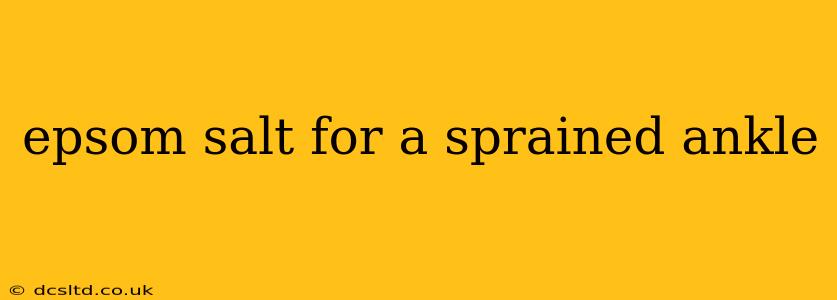A sprained ankle, a common injury resulting from a sudden twist or forceful turn, can cause significant pain, swelling, and limited mobility. While medical attention is crucial for severe sprains, many find relief using home remedies, and Epsom salt soaks are among the most popular. But do they actually work, and how should you use them? This article delves into the benefits, methods, and precautions associated with using Epsom salt for a sprained ankle.
What is a Sprained Ankle?
Before we explore the Epsom salt remedy, let's understand what constitutes a sprained ankle. A sprained ankle involves damage to the ligaments—the tough bands of tissue that connect bones—surrounding the ankle joint. The severity varies from mild (stretching) to severe (complete tear). Symptoms typically include:
- Pain: Ranging from mild discomfort to intense throbbing.
- Swelling: Accumulation of fluid around the injured area.
- Bruising: Discoloration of the skin.
- Limited range of motion: Difficulty moving the ankle.
- Instability: Feeling of the ankle giving way.
It's crucial to seek professional medical advice for any significant ankle injury to rule out fractures or other serious conditions.
Does Epsom Salt Help a Sprained Ankle?
Epsom salt, chemically known as magnesium sulfate, is a naturally occurring mineral compound. When dissolved in warm water, it creates a soak that's believed to offer several benefits for sprained ankles:
- Pain Relief: The magnesium in Epsom salt may help reduce inflammation and pain by interacting with nerve endings. While the exact mechanism isn't fully understood, many individuals report pain reduction after Epsom salt soaks.
- Reduced Swelling: The magnesium sulfate may help draw fluid from the swollen tissues, thus reducing inflammation.
- Muscle Relaxation: The warmth of the water and the magnesium can promote muscle relaxation, easing stiffness and discomfort.
How to Use Epsom Salt for a Sprained Ankle?
For an Epsom salt soak, follow these steps:
- Dissolve: Add 2 cups of Epsom salt to a basin or tub filled with warm (not hot) water.
- Soak: Immerse your injured ankle in the solution for 15-20 minutes.
- Repeat: You can repeat this process 2-3 times a day, depending on your comfort level.
- Elevation: After the soak, elevate your ankle above your heart to further reduce swelling.
- Rest: Avoid putting weight on your ankle as much as possible during the healing process.
How Long Does It Take for Epsom Salt to Work?
The time it takes to notice relief from Epsom salt soaks varies from person to person. Some may feel immediate pain reduction, while others might see improvements over a few days. It's important to remember that Epsom salt is a complementary therapy and not a standalone treatment for a sprained ankle.
What are the Side Effects of Epsom Salt?
Generally, Epsom salt soaks are considered safe, but some individuals might experience:
- Skin irritation: If you have sensitive skin, dilute the solution or test a small area first.
- Dehydration: Prolonged soaking can lead to dehydration, so ensure you drink plenty of water.
- Allergic reactions: Rarely, some individuals might experience allergic reactions to Epsom salt.
Can Epsom Salt Heal a Sprained Ankle?
No, Epsom salt cannot heal a sprained ankle on its own. It's a complementary therapy to help manage pain and inflammation. Proper healing requires rest, elevation, ice (in the initial stages), compression, and potentially physical therapy, depending on the severity of the sprain.
When Should I See a Doctor for a Sprained Ankle?
You should consult a doctor if:
- You experience severe pain.
- There is significant swelling or bruising.
- You cannot bear weight on your ankle.
- The pain persists for more than a few days.
- You hear a popping sound during the injury.
Ignoring a severe sprain can lead to long-term problems, so seeking timely professional medical advice is essential.
Can I Use Epsom Salt with Other Treatments?
Epsom salt soaks can complement other treatments, such as icing, elevation, and over-the-counter pain relievers. However, always consult your doctor or physical therapist before combining different therapies to avoid potential interactions.
In conclusion, Epsom salt soaks can be a helpful complementary therapy for managing the pain and inflammation associated with a sprained ankle. However, they are not a replacement for proper medical care and should be used in conjunction with other recommended treatments to ensure a complete and speedy recovery. Remember, prompt medical attention for any significant ankle injury is crucial.
